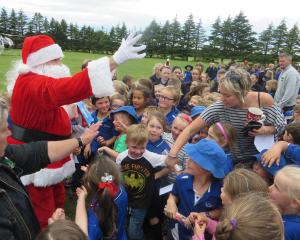Turkey is traditional Christmas fare but cooking one can be daunting.
Daniel Pfyl, hospitality management lecturer at Otago Polytechnic, shares some professional techniques with Charmian Smith for when it comes to cooking and carving your turkey this Christmas.
Plan ahead
If your turkey is frozen, put it in the fridge to defrost for at least 24-36 hours before you want to use it.
You need to allow about 20min cooking per 500g, so a 4.5kg turkey will take about 3 hours.
Most turkeys have a gadget that pops up when they are cooked, but you can test if it is done by cutting between the thigh and body and seeing if the juices run clear.
However, Chef Pfyl recommends the best way of judging whether the bird is cooked is to insert a thermometer into the centre.
If it measures 75-80degC it is done but not overcooked.
Preheat the oven to 200degC to start, and after the turkey has been cooking an hour, reduce the temperature to 160degC fan or 180degC non-fan.
Chef Pfyl likes to use fan bake because the temperature is more even throughout the oven.
The turkey then needs to rest for 30 minutes in a warm place before carving.
Safety first
When handling raw poultry (turkey or chicken) it is important to wash everything - hands, board, knife and other utensils thoroughly after using so they do not contaminate any other food.
Professionals use gloves as well. Raw poultry may harbour salmonella bacteria that can cause illness.
Cooking it properly kills the bacteria; that is why it is important to check it has reached the correct internal temperature.
Preparation
Take the defrosted bird out of the plastic bag. Remove the giblets from the cavity.
The liver can be chopped and cooked to include in the stuffing if you like, and other pieces such as the neck can be put under the turkey while it roasts to add flavour to the gravy, if you are making it.
Dry the inside and the outside of the bird with paper towels.
You can take out the wishbone if you like - this makes it easier to carve later, but means you don't have fun making a wish with someone.
To remove the wishbone (the V-shaped bone at the neck) pull back the neck skin and use a small sharp-pointed knife to scrape the flesh away from the bone on all sides and cut through the tendons.
Hold the free ends of the bone and twist to pull it out.
Cut the tips off the wings and put them with the giblets to use later under the turkey while roasting.
Check the outside for the remains of any feathers - our Crozier's free-range turkey was well plucked.
Simple sage and onion stuffing for turkey (or chicken)
1. Chop a medium-sized onion finely.
2. Remove the leaves from a bunch of fresh sage and chop finely. Dice about half a loaf of bread (no need to remove crusts) or make fresh breadcrumbs and add to the bowl with the onion and sage. Don't use dried breadcrumbs as they make the stuffing taste like sawdust.
3. Break two eggs into the bowl and moisten with a little milk - the amount you need depends on how dry your bread is.
4. Season with salt and pepper then mix and squeeze with your hands or mix with a stand mixer (a processor will chop it too finely).
5. Press some of the stuffing in your hand and if it holds together in a moist lump it is the right consistency. If it is too dry, add more milk or even another egg. You can make the stuffing ahead of time and leave it in the fridge overnight if you wish, but check the consistency before you use it.
Stuffing
Put the stuffing in the rear and neck cavities. Don't overfill as the stuffing will expand during cooking.
Any spare stuffing can be rolled into a sausage shape, wrapped in buttered tinfoil and cooked with the roast potatoes or added to the turkey pan for the last hour.
Seasoning
1. Mix salt, a little paprika (for colour) and pepper and sprinkle over the bird. Rub into the skin with some oil.
You could use clarified butter instead of oil, but ordinary butter is likely to burn.
2. Chef Pfyl pushed sideways against the legs which forces up the breast, breaking some of the rib bones and making the turkey look plumper.
3. To keep it in shape, tie with cotton string (don't use plastic-coated stuff which will melt in the oven). Put the string under the tail and cut it so there is about 70-80cm each side.
Cross the string over the ends of the drumsticks, then under them in a figure eight. Bring the string along the sides and tie tightly behind the neck.
4. Cover the breast with rashers of bacon and tie on loosely.
This prevents the breast drying out, but remove these for the last hour or so of cooking to allow the breast to brown.
Roasting
1. Place the bird in a roasting pan with a little oil.
2. Chef Pfyl likes to cook the turkey on each side for half an hour at 200degC. The legs take longer to cook than the breast and this gives them a good start, he says.
3. After the first hour (half an hour on each side), he turns the heat down to 160degC to 180degC and turns the bird on to its back and puts it on a trivet or puts the cut-off wing tips, neck and giblets underneath it to raise it above the drippings.
4. Half an hour before the turkey is cooked, take off the bacon and baste the breast with the juices in the pan - tip the pan so they run into a corner and spoon them over the breast to keep it moist, or use a baster.
5. When the bird is done - check the internal temperature (75-80degC) or check that the juices run clear - remove it from the pan, cover with tinfoil and allow it to rest for about 30min in a warm place.
This allows the juices to spread through the meat. It also gives you time to make the gravy if you wish.
Gravy
1. Pour off most of the fat, reserving the juices. Add a little flour to the remaining fat in the roasting pan and stir in.
2. When browned, add reserved juices, stock, wine, or water in which vegetables have been cooked, and stir up the tasty brown bits in the bottom of the pan.
3. When it comes to the boil, taste and add salt and pepper to taste, and more liquid if needed. Strain if you like.
To carve and serve
Use a sharp knife.
1. Cut and remove the string.
2. Cut off the drumstick and, holding the bone, carve slices downwards.
3. Cut off the thigh and carve slices crossways so there is a little crisp skin on each.
4. Cut across above the wing and below the breast (this is easier if you have already taken out the wishbone), to allow the breast to be sliced easily.
5. Carve slices down the breast to the cut.
6. Lift out the stuffing with the knife or a spoon, and slice it.
7. Serve with cranberry sauce or spiced fruits.
In hotels they often bone and roll the turkey so it is easier to carve, Chef Pfyl says.
Leftovers
Refrigerate leftover turkey and use it cold in salads or wraps or in any recipe for cooked chicken.
Chef Pfyl suggests making Mexican quesadillas: sandwich sliced turkey, cranberry sauce and Camembert cheese between two tortillas.
Pan-fry on both sides until golden and the cheese has melted, then cut into wedges.














